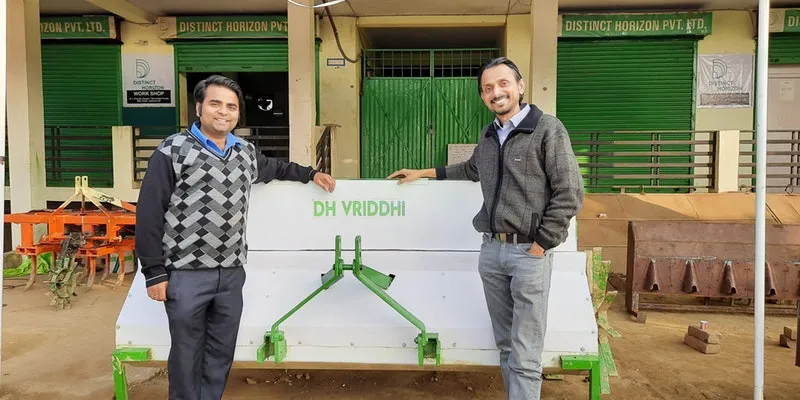This agritech startup has developed a machine that will increase productivity by 25 percent
Distinct Horizon’s patented DH Vriddhi is a tool that helps farmers place fertilisers deep into the soil, using the Urea Deep Placement (UDP) technique, reducing excess use of fertilisers and increasing crop productivity.
According to the Food and Agriculture Organisation of the United Nations, agriculture, with its allied sectors is the largest source of livelihoods in India. Seventy percent of the country’s rural households still depend primarily on agriculture for their livelihood. However, as the Indian economy has diversified and grown, agriculture’s contribution to GDP has steadily declined from 1951 to 2011.
The agricultural sector in India is plagued by a number of issues that include small and fractured landholdings, lack of fertile seeds, irrigation, insufficient mechanisation, and more.
Low crop production is mainly caused by the excess use of chemical fertilisers and pesticides, which also leads to decline in quality. Constant innovations and newer technologies are needed to address the issue of decrease in quality and quantity of production.

Santosh Kumar and Ayush Nigam
One such innovation launched by , a Delhi-based agritech startup seeks to address food production, while protecting the ever-degrading environment. Its end goal? To double the profits of marginalised farmers across the developing world.
Founded by Ayush Nigam, an IIT-Madras alumnus along with his friend Santosh Kumar, an electronics engineer from Galgotia College of Engineering and Technolgy, Distinct Horizon has patented DH Vriddhi, a tool that helps farmers place fertilisers deep into the soil, using the Urea Deep Placement (UDP) technique thereby reducing the use of fertilisers by 30-40 percent by, thereby increasing crop productivity. Its use has increased productivity by 25 percent for over 450 plus farmers so far.
How it all began
After graduating from IIT-Madras in mechanical engineering, Ayush worked in different corporate entities until 2011. He ventured into the social innovation lab concept for four years with other young innovators.
The motive to venture into the social sector that too specifically in agriculture goes back to discussions with his friend Santosh during their college days. The friends discussed the state of the rural economy, in particular the challenges in the agricultural sector.
Once they were sure of the path, they travelled across rural India and Bangladesh and along the way, met Birendra Bahadur Singh, former Head, New Business Development, Tata Chemicals. The former executive informed the duo about the huge issue with current fertiliser application practices that led to low productivity and was responsible for large-scale climate change and water pollution.

The Team
Innovative farming method
They realised the need for an applicator, a machine that would place fertilisers deep into the soil and enhance the overall growth of the crops. It’s based on the concept of Urea Deep Placement or Fertilizer Deep Placement (UDP / FDP) that can double farmers’ profits, reduce chemical inputs and have a very significant impact on the environment, all in one go.
After working with farmers across six states for four years, the team learnt that in order to convince farmers to shift to a much superior practice, demonstrations must be conducted locally. To develop the overall product, it also worked with IDEO.org for designing and manufacturing the machine, with a factory in Lucknow.
DH Vriddhi, is designed in a way that it can be integrated with tractors and power-tillers. The design also allows the machine to place fertiliser pellets at a depth of three inches below the soil and cover an acre in 30-45 minutes and is 60 times more efficient than conventional methods.

DH Vriddhi in the making
With the help of deep placement of fertiliser, oxidation of nitrogen is avoided, which in turn reduces nitrous oxide, a major greenhouse gas that causes 298 times more global warming than CO2, from the fields.
By deep placing of the fertiliser, the machine also stops run-off of the fertiliser with water, thus avoiding water pollution, as fertiliser run-off water is a major cause of water body pollution or ‘eutrophication’.
Ayush says, “In terms of global warming reduction, DH’s technology reduces it by five times in comparison to solar panels, and in just 40 percent of the time.
Reaching out to farmers
The team conducted demo sessions for farmers by partnering with Tata Trusts, Dr Reddy’s Foundation and Syngenta Foundation for Sustainable Agriculture to make them aware of this new concept and help them shift to a better technology. It has piloted its technology in five states.
“The government is also working to popularise the technology across India. In the initial trials we received a demand for providing paid service to over 6,000 farmers across the different locations in a short period. The company is therefore very confident about the demand for this technology,” says Ayush.

He adds, “A group of farmers in Mukhlispur village, Lakhimpur Kheri district, Uttar Pradesh, were not convinced about the results when we informed them initially. When we pushed them to try it, they gave us the worst patches of land that were unproductive to us for demos. After a month, they were completely shocked seeing the health of the plants, that too with much lesser input cost. They also achieved a 13 percent higher produce than the other fields nearby. Now the entire village is looking forward to our technology and its results, following these demonstrations.”
A farmer can buy the an applicator for Rs.1.2 lakh excluding the subsidy directly from DH. According to the founders, the machine will soon be available via regular agri distribution networks as well as startups in the space of machinery selling and renting.
The road ahead
The startup received the USISTEF Grant (a joint grant by US and Indian governments for high impact technology development) for development of the technology. It has also received funding from Tata Chemicals and CIIE.
Ayush is optimistic about the future of DH Vriddhi. “We plan to take this technology to a million farmers by 2023, and thus, double profits of these farmers, reduce environmental damage and increase food production by 25 percent.”
(Edited by Rekha Balakrishnan)







